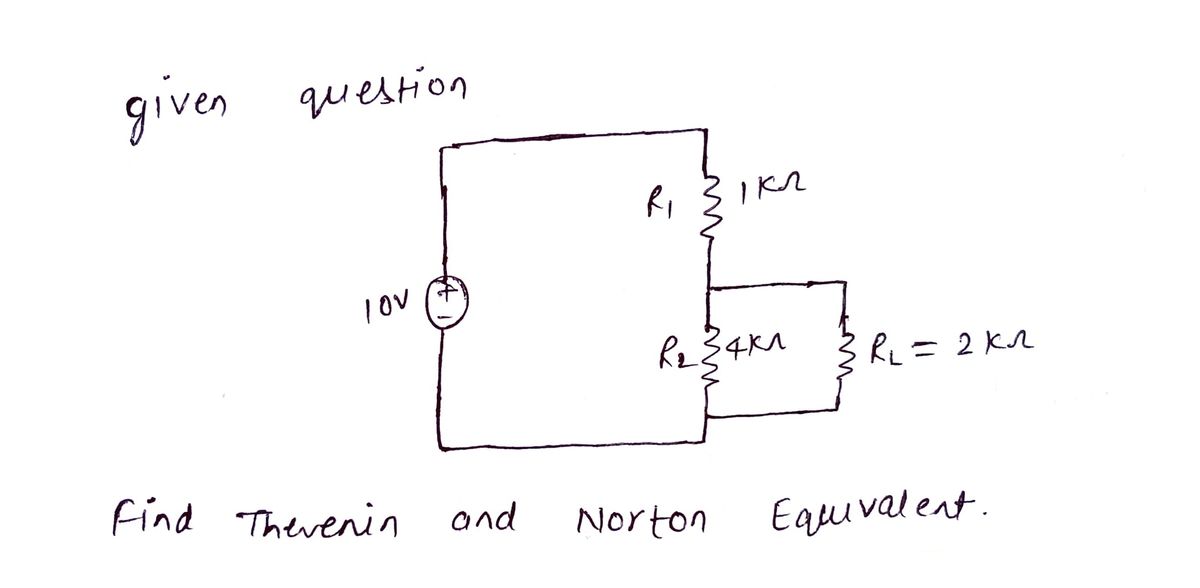Find the Thevenin & Norton equivalent of the following circuit. 10V R₁ = 1kn R₂ = 4k www. RL = 2kS
Find the Thevenin & Norton equivalent of the following circuit. 10V R₁ = 1kn R₂ = 4k www. RL = 2kS
Introductory Circuit Analysis (13th Edition)
13th Edition
ISBN:9780133923605
Author:Robert L. Boylestad
Publisher:Robert L. Boylestad
Chapter1: Introduction
Section: Chapter Questions
Problem 1P: Visit your local library (at school or home) and describe the extent to which it provides literature...
Related questions
Question

Transcribed Image Text:**Transcription and Explanation for Educational Website**
**Topic:** Finding Thevenin and Norton Equivalent Circuits
**Objective:** Learn how to find the Thevenin and Norton equivalents of a given circuit.
**Circuit Description:**
The circuit consists of the following components:
1. **Voltage Source:**
- A 10V DC voltage source is present on the left side of the circuit.
2. **Resistors:**
- \( R_1 = 1 \text{k}\Omega \)
- \( R_2 = 4 \text{k}\Omega \)
- \( R_L = 2 \text{k}\Omega \)
**Circuit Layout:**
- The 10V voltage source is connected in series with \( R_1 \).
- \( R_2 \) is connected in series with the combination of the voltage source and \( R_1 \).
- The load resistor \( R_L \) is connected across the terminals of \( R_2 \).
**Problem Statement:**
"Find the Thevenin & Norton equivalent of the following circuit."
**Graphical Representation:**
- The schematic shows a simple series circuit arrangement with a voltage source and resistors.
- There is no graph or diagram beyond the schematic illustration of the circuit itself.
**Educational Focus:**
- Understand the process of simplifying circuits using Thevenin's Theorem by determining:
- **Thevenin Voltage (\( V_{th} \))**: The open-circuit voltage across the terminals where \( R_L \) is connected.
- **Thevenin Resistance (\( R_{th} \))**: The equivalent resistance seen from the open terminals when independent sources are deactivated.
- Apply Norton's Theorem to find:
- **Norton Current (\( I_{no} \))**: The short-circuit current through the terminals.
- **Norton Resistance (\( R_{no} \))**: Same as the Thevenin Resistance in this case.
**Learning Outcome:**
- Upon completion, you should be able to simplify complex circuits using Thevenin and Norton equivalent models to facilitate easier analysis and understand practical applications.
**Additional Notes:**
- Thevenin and Norton theorems are powerful techniques for circuit analysis and essential tools for electrical and electronics engineering students.
Expert Solution
Step 1: Given question

Step by step
Solved in 3 steps with 3 images

Knowledge Booster
Learn more about
Need a deep-dive on the concept behind this application? Look no further. Learn more about this topic, electrical-engineering and related others by exploring similar questions and additional content below.Recommended textbooks for you

Introductory Circuit Analysis (13th Edition)
Electrical Engineering
ISBN:
9780133923605
Author:
Robert L. Boylestad
Publisher:
PEARSON

Delmar's Standard Textbook Of Electricity
Electrical Engineering
ISBN:
9781337900348
Author:
Stephen L. Herman
Publisher:
Cengage Learning

Programmable Logic Controllers
Electrical Engineering
ISBN:
9780073373843
Author:
Frank D. Petruzella
Publisher:
McGraw-Hill Education

Introductory Circuit Analysis (13th Edition)
Electrical Engineering
ISBN:
9780133923605
Author:
Robert L. Boylestad
Publisher:
PEARSON

Delmar's Standard Textbook Of Electricity
Electrical Engineering
ISBN:
9781337900348
Author:
Stephen L. Herman
Publisher:
Cengage Learning

Programmable Logic Controllers
Electrical Engineering
ISBN:
9780073373843
Author:
Frank D. Petruzella
Publisher:
McGraw-Hill Education

Fundamentals of Electric Circuits
Electrical Engineering
ISBN:
9780078028229
Author:
Charles K Alexander, Matthew Sadiku
Publisher:
McGraw-Hill Education

Electric Circuits. (11th Edition)
Electrical Engineering
ISBN:
9780134746968
Author:
James W. Nilsson, Susan Riedel
Publisher:
PEARSON

Engineering Electromagnetics
Electrical Engineering
ISBN:
9780078028151
Author:
Hayt, William H. (william Hart), Jr, BUCK, John A.
Publisher:
Mcgraw-hill Education,